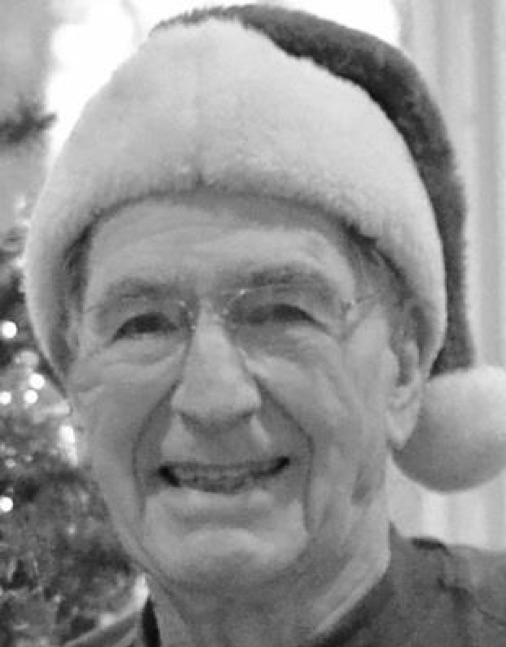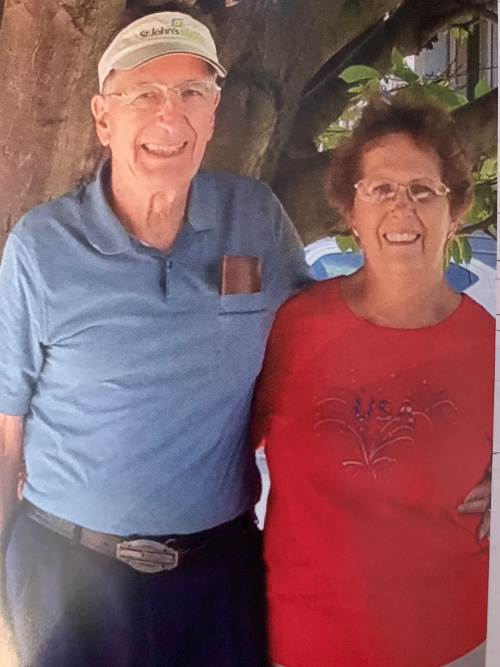![[Photos and Features]](../jpg/articlestop.jpg)
Message from Merry Hinkle |
Many Rochester Area round dancers have enjoyed Merry Hinkle’s
cueing. She has cued at many of our dances over the years, and has
been a regular at Dance-O-Rama. So, with Merry’s permission, we are
sharing her message to dancers at the Hinkle Round Dance Club
(established in 1995 with her husband, Dick), on Wednesday, Jul 15,
2020, announcing closure of the club.
Note that Merry is not retiring. She will continue to dance and cue as
opportunities arise.
Here is Merry’s message:
Dear Dancers,
Dancing has been in my life since 1982. It has taken Dick and me to
meet so many wonderful people from all over and taken us all over the
world … dancing.
Some of my best memories all came thru dance … As Square
Dance presidents we put on a Christmas Party for 22 squares at a venue
with no kitchen. Put on Happy Holly Daze Round Dance parties for many
years with attendance up to 75 couples. When you have the numbers, you
can do anything. PLUS, you must have good venues.
Probably a great accomplishment was as Chairmen of Roundalab’s
Advertising, we were instrumental in designing the bumper stickers and
getting that 1-877-Y-I- Dance phone number. Thousands of those bumper
stickers were printed and handed out at the 2000 T&D and Roundalab
Conventions. When we are young and infallible we can do anything.
The most difficult time was when Dick fell ill and still wanted me to
keep the club going. In the beginning, I had Ted & Ella to help me
set up. Grace ran the kitchen … hmmmmm, I could do
this! Then as we age, the numbers get smaller, the load gets
heavier. Thanks to Bob & Don helping put equipment away and all my
little helpers in the kitchen to help clean up.
But being a one-man show was becoming a challenge, making the correct
decision to cancel due to weather, raising fees due to rent increase
or equipment breaking down. Not to mention attendance was
waning. We’re aging! NOW one more hurdle … COVID 19!
Whoever thought in March we were facing a major pandemic all over the
world!!! Masks, sterilization, social distancing … no
hugging … no handshakes. Socialization is what our dancing is
about.
It has been an honor and privilege to cue for you, we’ve had a great
26-year run with this dance club, but sadly after much consideration,
time has come to put it to bed. I’m not giving up cueing or dancing,
we still have to dance. It’s just that time has come to give up the
club, less work and responsibility. Lots of thought has gone into this
very difficult decision.
I would like to thank each and every one of you for being a part of
this journey, your loyal support and for sharing the love of dance
with me. I will truly miss each and every one of you and I HOPE and
PRAY we keep in touch. See you on the dance floor somewhere soon.
Love to all of you, and long-distance hugs,
Merry
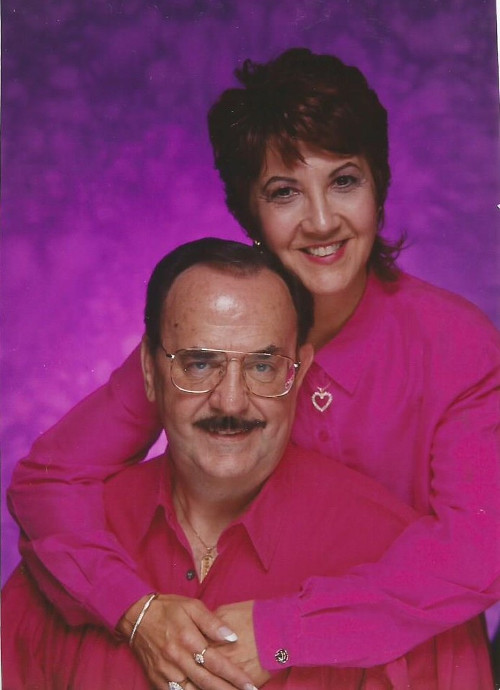
Dick and Merry Hinkle
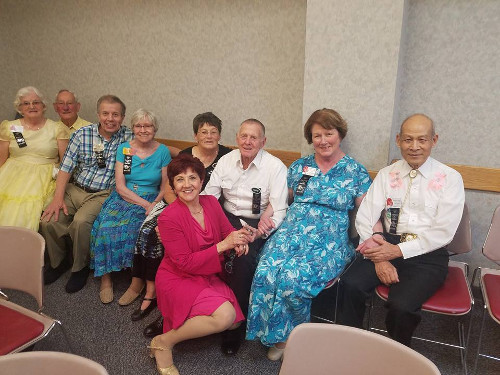
Merry at DOR 2018—the 60th Anniversary
Dancing versus COVID-19 |
The COVID-19 virus has “paused” nearly all in-person dancing
worldwide and pushed callers and dancers to new ways of gathering to
dance. In our area, the Belles & Beaus, Silver Squares, Shirts
& Skirts, and Village Squares have all been using Zoom to get
together for weekly chats from their own homes. Shamrock Squares are
dancing one square weekly in Mike Callahan’s basement, and The
Enovators are doing about the same. Cayuga Cut-Ups have been dancing
in the outdoor patio area at Bailiwick Market & Cafe, in Elbridge
NY. Others have organized group walks and “distanced”
picnics. Anne Granger (Silver Squares) even scheduled a family square
dance in her back yard, with Mike Callahan calling. (See the “Photos
& Features” section for photos)
Some callers—local, national and international—are dancing in
their homes, connected via Zoom and other group video
platforms. Locally, Gil Porter is calling a “two-couple” Zoom
dance for the Pandemic Squares every Wednesday from 8 to 9pm. Contact
Brenda Bixby or Peter Emmel for a Zoom invitation.
The big question is “When will we get back to normal dancing?”
Well, it’s complicated. First of all, right now most normal dancing
venues are not allowing gatherings as large as a typical square
dance. Secondly, most dancers are planning to be very careful about
their return to dancing. We’ll get back to that in a
moment. Thirdly, it’s not clear exactly what “normal” will
look like whenever dancing becomes practical and fun once again.
We’ll discuss possibilities for what the “new normal” might
look like in a separate article, but here we’ll focus on dancer
attitudes related to their personal decision to return.
SURVEY RESULTS
Some weeks ago, the RAF asked members of all area clubs to answer a
series of questions. The goal was to gauge directly what conditions
would have to be met for dancers to be comfortable returning to the
dance floor. The accompanying graphics (HERE) show the distribution of
results.
The results showed that of the approximately 250 respondents, more
than half indicated the following safety concerns under COVID-19
Pandemic:
- Are not sure when they will return to dancing
- Want masks worn by everyone for dancing and socializing
- Want social distancing required at the venue
- Are concerned about the cleanliness and sanitation of the facilities
- Want hand sanitizers and wipes available
- Commented on the availability of hand-washing
- Want minimized personal contact among dancers
- Want dancers to bring their own water & snacks or provide prepackaged water & snacks
- When dancing returns, want dances formatted as refreshers or workshop sessions
Additional feedback came in the form of comments, with the most common being “Dancers should dance in same square all evening to minimize the number of contacts.” This can be accomplished by self-selecting or by random drawing before the first tip.
The USDA News (July–Sept Issue), gives additional suggestions, many of which are also found in RAF survey comments:
- One person to sign dancers in (instead of two plus greeters)
- Consider paying by check versus cash (less “public” handling)
- Log contact information for dancers and visitors in case someone becomes sick
- Take dancers temperatures prior to entering the facility? (wand or temple thermometer) (Anyone with temp over 100.4 would not be allowed inside)
- Anyone who becomes ill after the dance would be requested to contact club presidents
I know in my case, I don’t want any chance that an event that I promote will end up making any of my friends sick—or worse.
SILVER LINING?
However, there is one big potential positive that could come out of this distressing time. If we put our minds to it, we should be able to find ways to re-build square dancing into a more sustainable activity. We could use this time to identify and correct some of the things that have led to low or negative growth for most clubs in the past 20–30 years.
In August, Jeff and Debbie Blood convened the annual meeting of RAF club presidents. One outcome, supported by club leaders and callers, was the decision to form a task force of dancers, club leaders and callers to study options and recommend a path for our “Return to Dancing.”
Getting dancers back on the floor at our various clubs after COVID is basically a club responsibility, but as with the national COVID response, it will be helpful to have guidelines and best practices outlined by the RAF. They would serve as a focus for discussion and default option for club leaders.
Other identified concerns of the task force will likely include:
- Outline an on-ramp back into dancing, probably with a “Refresher/tuneup” format and an intensive “call-back” campaign to re-connect with recent grads.
- Work out when and how to restart classes: What teaching program (SSD [Sustainable Square Dance 50 call system] or other)? What promotional pitch (social rebound, “class” or “fun” etc.)? When to restart classes?
- Look ahead to the future of square & round dancing (back too normal? back to the heydays? new paradigm?)
Copy Cats Present Club’s Annual Rathke Award |
At an outdoor gathering on August 11, 2020, the Copy Cats presented
their annual service award to David and Mary Jo Webster. Following is
the citation read by Rick and Donna LaDonna in making the
presentation.
RICK: The Rathke Award was first presented by the Copy Cats in
1982. The first recipients were Jim and Pearl Rathke who were
recognized for their outstanding support of the Club. Jim was a
fun-loving person who with Pearl supported the club in many ways and
they are also remembered as people who raised the spirit of the club
doing whatever was necessary. The Rathke Award has continued to be
awarded to individuals or couples who have been significant
contributors to the club. With few exceptions, this award is presented
annually.
DONNA: Our 2020 Rathke Recipients have been active in square dancing
for the past 8 years. They’ve danced locally and nationally. They
are always willing to participate in our Kitten Classes, picnics and
dances. In addition, they have hosted square dances in their garage
and also willingly participate in square dance demonstrations at local
nursing homes and other venues.
They are both active in the community—volunteering at their local
food pantry, driving individuals to doctor’s appointments and
volunteering at their local hospice. He participated in our first-ever
Copy Cats Fashion Show, helped distribute food to the Penfield
Ecumenical Food Shelf after our annual Thanksgiving food collections
and entertained us with his jokes and dance routines. She was Copy
Cats Treasurer for two years, organized several of our holiday dinner
dances, and currently serves on the DOR Refreshments Committee and is
the Copy Cats Sunshine Chair. Volunteering is this couples’ middle
name.
RICK AND DONNA: With great pleasure we introduce you to our dear
friends, partners in crime and the 2020 Rathke Award Recipients—David and Mary Jo Webster!
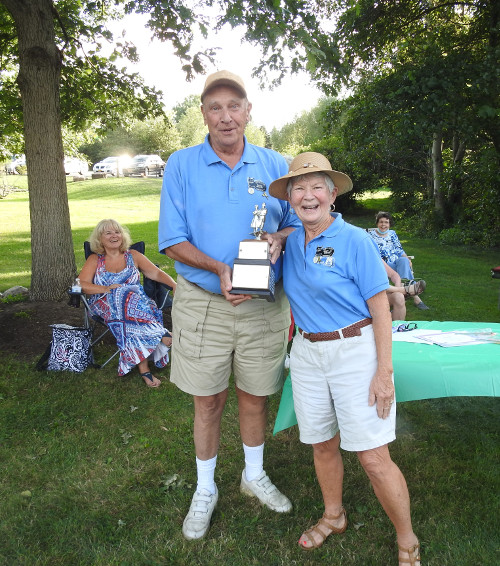
Silver Squares host Picnic on August 3 |
On August 3, 2020, the Silver Squares hosted an outdoor picnic gathering in the pavilion adjacent to their dance venue, Greece United Methodist Church. It was a beautiful day and about 30 people attended, from several clubs.
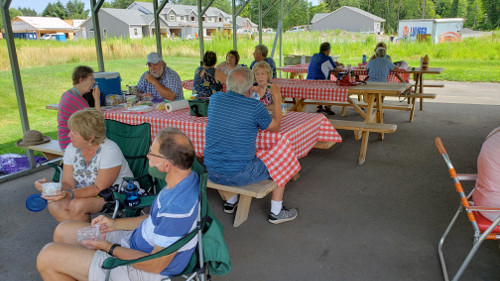
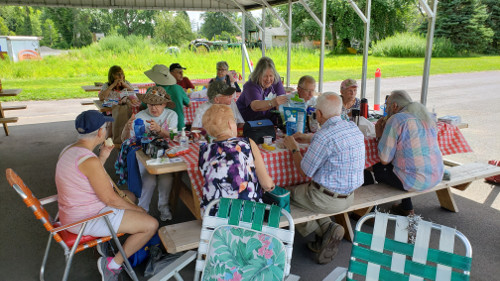
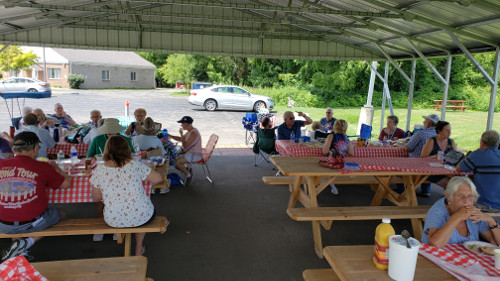
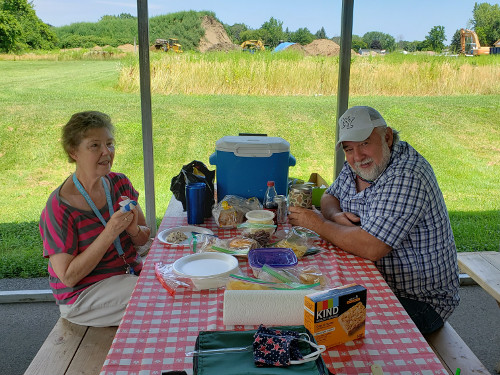
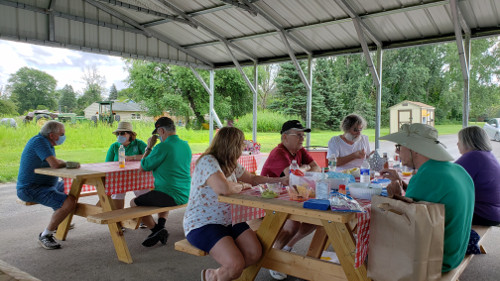
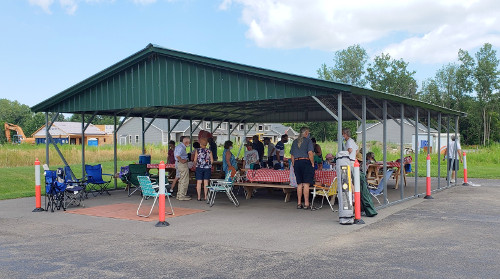
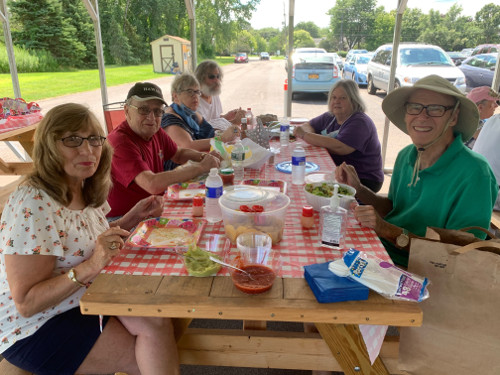
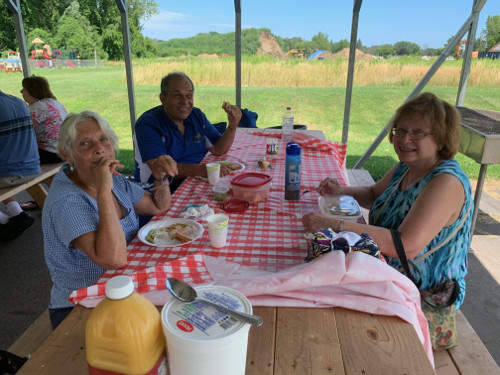
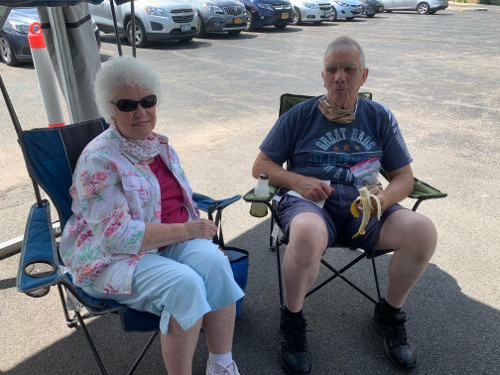
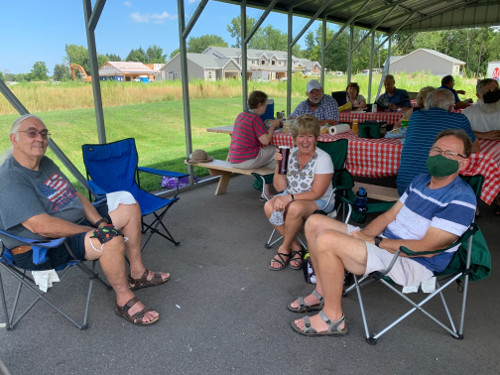
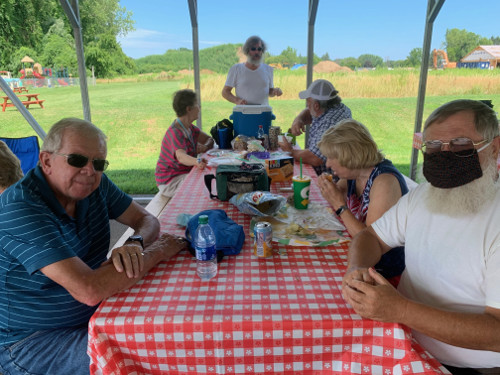
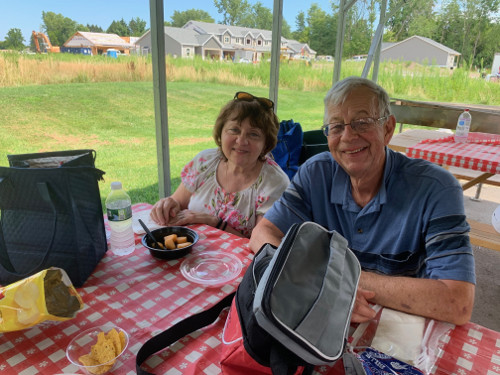
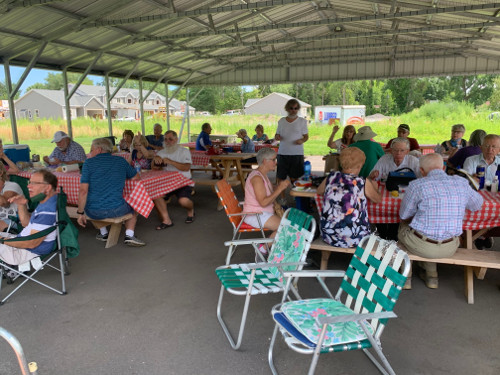
Shamrock Squares — Dancing One Square at a Time |
Adapting to COVID-19 times, Mike and Wanda Callahan are hosting Mike’s
weekly ‘A’ level dancing group, the Shamrock Squares, at their home.
They began hosting five couples at their home when limited gatherings
were permitted within NYS Phase 3. Their space holds one square, so
the Shamrock group has sorted into two squares, dancing on alternate
weeks with Dale Nientimp coordinating the five couples who attend each
week. Jim Gotta has also called for the group.
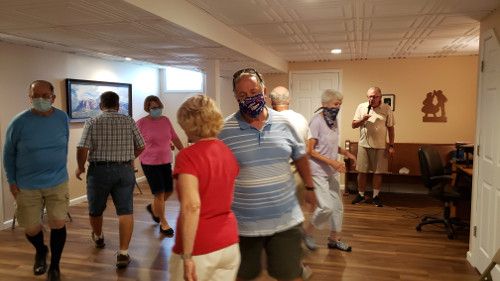
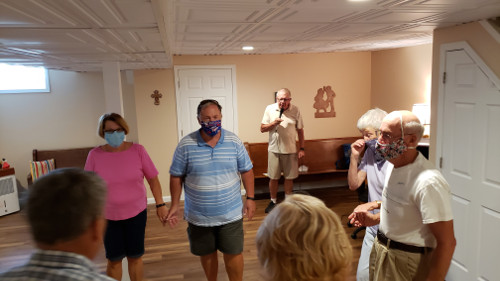
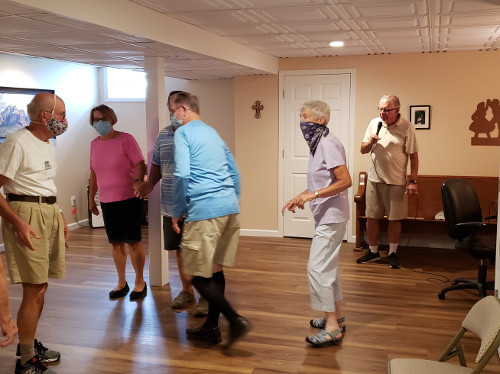
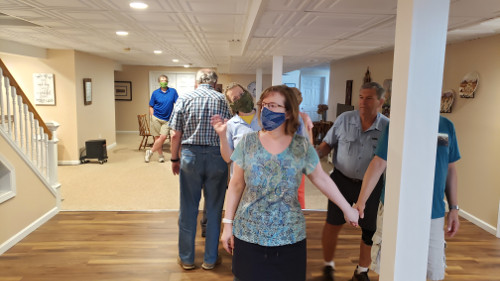
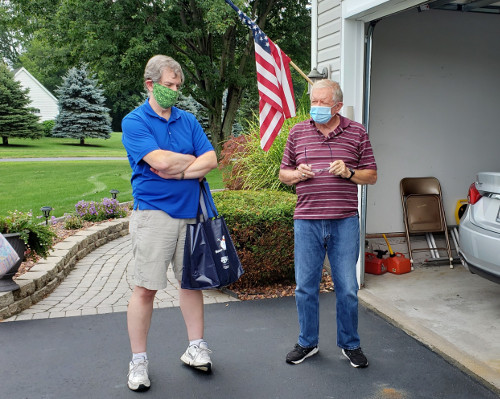
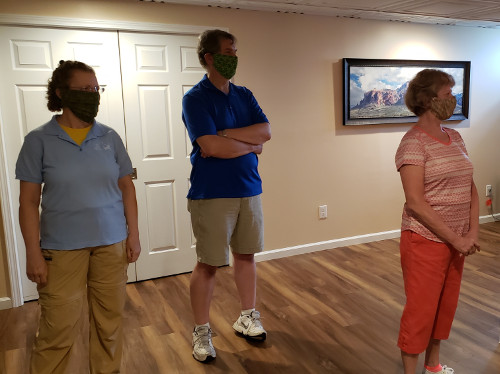
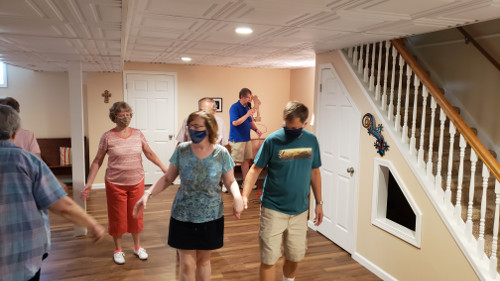
Mike Sikorsky Benefit Dance Hosted by Tom & Joan Powers |
On Saturday, August 15, the “remote dancing” group known as ONE
Square International hosted two live on-line video sessions for the
benefit of their colleague, Mike Sikorsky. The event brought
(virtually) together marquee national callers: Ken Bower, Wade Driver,
Tony Oxendine, Johnny Preston, Gary Shoemake and Mike Seastrom.
Anyone with an internet connection could tap in and watch or
listen … or dance. Tom and Joan Powers, and probably
others in our area, gathered a square of dancing friends in their
driveway to dance for the hour-long event. A little rain near the end
moved them to plan B—the garage.
Donations were collected to help defray the cost of Mike Sikorsky’s
medical treatment for an extremely serious condition that overcame him
in the past few months. Accompanying this article is a thank you
message from Mike. Many Rochester area dancers will remember him from
the annual summer RAF dance he has been calling, and from his guest
appearances at local clubs.
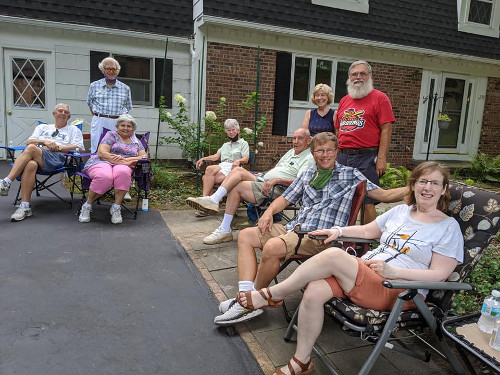
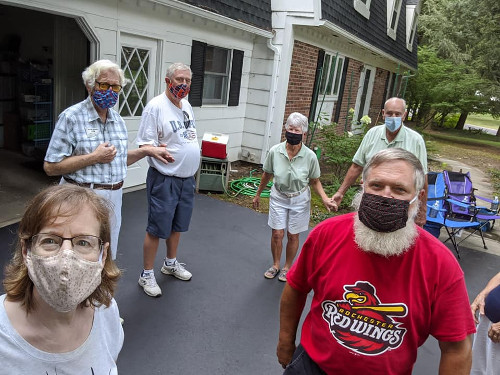
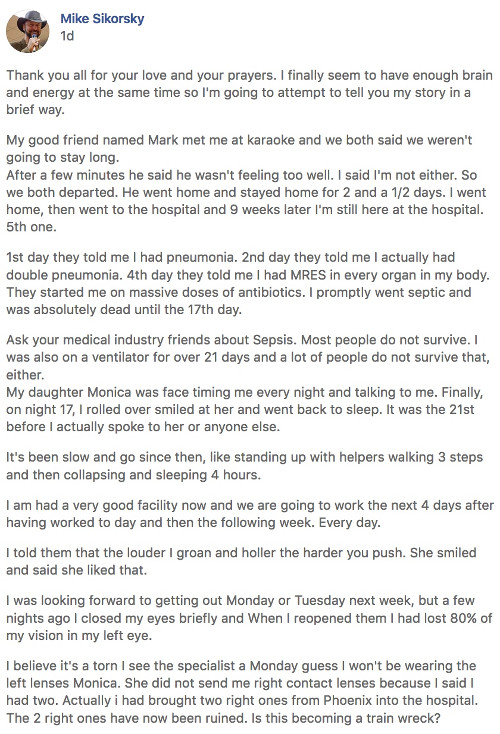
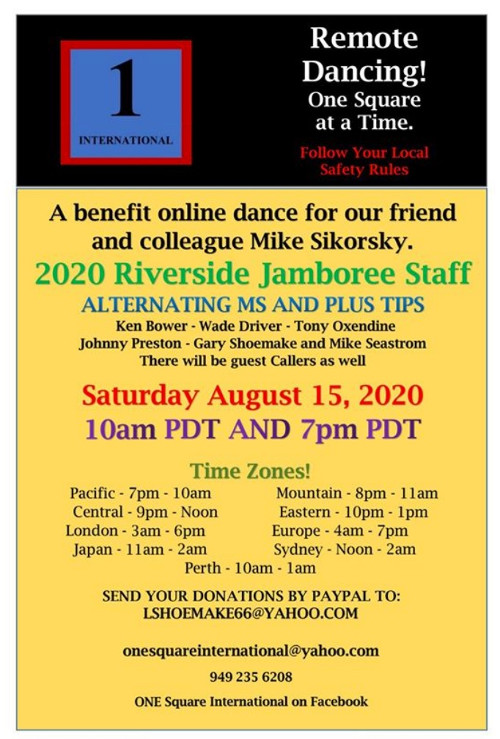
Village Squares Gather in Webster Park |
On July 22, in lieu of their traditional summer picnic, a group of
Village Squares gathered in and around the Valley View Shelter, near
the tennis courts at Webster Park. The weather looked ‘iffy’ for
most of the day, but it cleared up just in time. Social distances were
maintained and for many it was the first time speaking to one another
in person since March. Weekly Zoom chats are fun, but nothing beats an
in-person gathering.
Other clubs are arranging group walks and other outdoor events. I hope
they will send photos so we can share them with the rest of the square
dance community.
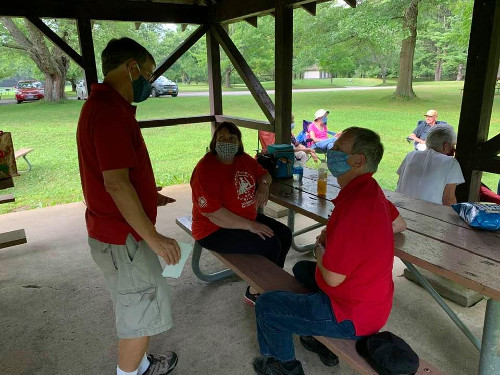
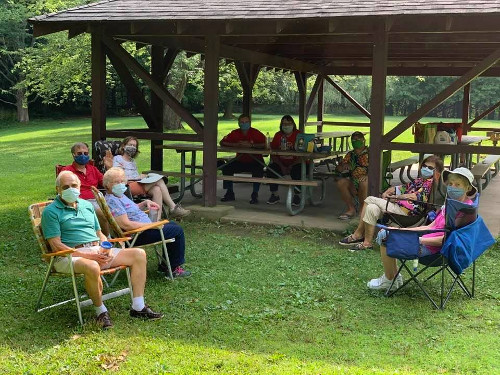
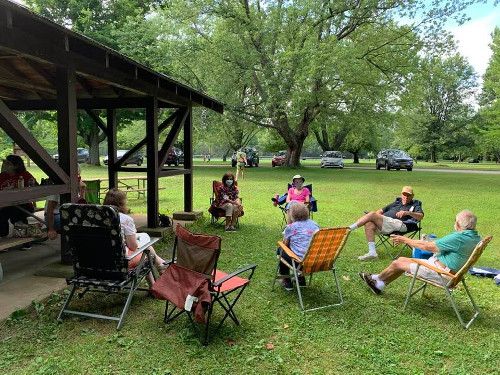
Cayuga Cut-Ups Dancing in Outdoor Patio |
The Cayuga Cut-Ups have found a restaurant, Bailiwick’s, with an open-air patio where they can dance through August in relative safety, with Ron Brown calling. The accompanying photos were taken at their June 25 dance.
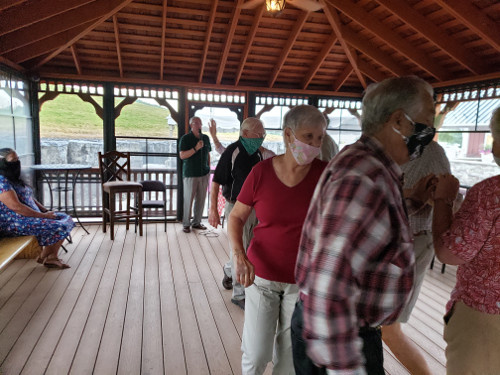
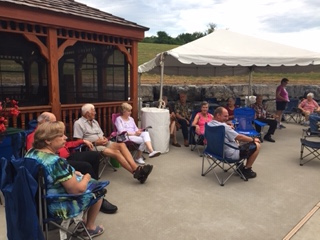
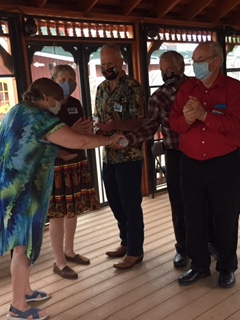
Social Square Dancing |
The forced gap in our dancing activities brings an unexpected
opportunity. Many established dancers are chafing to get back to the
dance floor. Others are more cautions, as evidenced in their responses
to the RAF questionnaire reported in another article. All of us, who
already know and love square dancing and the friends it has brought
us, are motivated to get back to it as soon as COVID-19 reaches our
personal safety threshold.
However, the rest of the world—including the next
generation of dancers—surely do not st see it that
way. Right now, those future friends and dancers will be looking at
our beloved activity as the last thing they want to start in on until
COVID-19 is in the rear-view mirror. For the next year or two,
promoting square dance classes to the public looks like an even harder
challenge than usual. But, when the COVID-19 cloud is lifted, I think
it’s reasonable to expect people to be looking for new social
activities.
So, what better time than now to review our thinking about how the
learning process for square dancing is organized and promoted?
This will be one of the questions addressed by the RAF’s
newly-formed “Return to Dance” task force, described in
another Promenader article in this issue.
The callers present at the RAF “Presidents meeting”
re-introduced the so-called SSD program, standing for “Social
Square Dancing.” It is a program of teaching that represents a
return to a more limited list of calls. New dancers can learn this
call set in significantly less time than the current Mainstream
program, and it could form the basis of a more
“accessible” dance community, with less emphasis on skill
levels. It has been tried in various parts of the country for several
years with mixed success. The “mixed” results come from
areas where it was adopted by too few clubs and was therefore not
supported by enough established dancers for it to take hold. In areas
where Mainstream/Plus dancing had completely died, it has led to rapid
growth and filled dance halls.
One possibility for taking advantage of the COVID-induced temporary
“death” of square dancing is to consider switching to a
program like this—when dancing comess back to life. With
that possibility in mind, and taking no particular position on whether
it should or should not be adopted, we present here a reasonably
thorough description of the SSD program by one of its avid fans. The
reason for publishing this is to give dancers an introduction to the
program before they hear of it via the grapevine, and to provide a
reference for those who want to look into it.
(For a “deeper dive” into SSD, you can watch this video presentation to hear
caller Noah Siegmann explain it to callers and answer questions. A
complete 47-page description including caller teaching materials is
posted at Callerlab’s website. The following article contains a
link to “Experimental Sustainable Square Dancing Teaching
Document” by scrolling to nearly the bottom of the Callerlab
page. It’s a PDF that the complete SSD teaching program.)
(Submitted by Peter Emmel)
What follows is an article by Gene Turner, an American now residing and calling square dances (for the Harmony Squares) in Yorkshire, UK. He wrote the article early in the COVID-19 shutdown. Since then, it has become widely distributed and was included by Jeff and Debbie Blood as a hand-out for the RAF meeting of club presidents in mid-August. We are reproducing it here with Gene’s permission, so that our readers can get a full picture of this program, which is bound to be discussed among callers and club leaders in the coming months.
A Possible Plan to Restart and Sustain Square Dancing?
By Gene Turner
“Learn to Square Dance! Classes start once a year! Sign up now
for weekly classes! Learn everything that you need to know about
Square Dancing in only forty-eight weeks!” What’s wrong
with those promotional statements? Why would anyone want to do that? I
would say, “No Way” to anyone who suggested that to
me. Why do we continue to think that our activity as it was (and has
been advertised in the past), would be attractive to the non-dancing
population?
The dancers in the clubs of today (pre-pandemic) need to be the seed
for the callers to form the clubs of tomorrow (post 2020) to grow and
continue this great activity. Yes, there will still be dancers wanting
callers to call M/S, Plus and Advanced (Puzzle-solving). Don’t
abandon them, but you need to be realistic and realize that the
dancers in these clubs have been decreasing in numbers long before the
pandemic. Realistically speaking, what has been tried for the past
thirty years wasn’t increasing the size of those clubs. The way
forward for our activity is to provide a simple, quick/easy to learn,
social, sustainable, Fun activity that could flourish if it were
properly supported by Callers and dancers. The existing format of our
activity is not simple, requires a commitment of nearly a year to
learn, it’s marginally social, and has been proven to not be
sustainable. The only thing that it had going for it was that after
investing years having fun learning, it was still mostly fun.
All callers need to educate themselves particularly in the art of
entertaining new dancers with the emphasis on having fun with simple
calls that new dancers can be introduced to early on. We need to
forget about puzzle-solving for our own sakes and let the dancers move
smoothly to the music and not have to concentrate so much on solving
puzzles. Yes, they need variety and some complexity in dancing so that
it’s not all done on autopilot, but not at the expense of
Fun. Primary to them having fun is the dancers having
success during their dancing experience.
We callers need to step up our game and make every night a
party dance and not a ‘class’ or ‘close order
drill’. Every dance MUST be fun! If new dancers learn
something while they are busy laughing and having fun, that’s
even better. We have to realize that if at the end of the evening,
they haven’t been having fun, that you probably won’t see
them again. It has to be fun every evening … more fun than
stayiing home, playing games on the computer, going to the pub, going
clubbing, watching TV … How difficult can that be?
Entertaining new dancers and giving them a fun evening is much
more important than teaching them. The Social Square Dance (SSD)
system might just be the answer. Refer to the Social
Square Dance (SSD) teaching document (click to download the
document) for a proposed twelve lesson system of ‘New Dancer
Dances’.
I encourage all clubs/callers to advertise their classes in future as
‘New Dancer Dances’. Then advertise ‘Welcome to our
New Dancer Dance #1; #2; #3; etc. Use the SSD system. Once
they’ve danced all twelve sessions, start again at #1 and the
previous ‘New Dancers’ move on to either become
‘Experienced SSD Dancers’ and/or ‘Angels’).
Remember the 60’s & 70’s … Square Dancing
greew because it was social and because it was fun and not too
complex. It also grew because new dancers could bring their friends
and their friends could start learning to dance too. If after starting
the system you find that your New Dancers want to bring their friends
along you don’t have to tell them “Sorry, not until next
year.” Plan now to start another New Dancer Group six weeks
after the first group, on a different night. The
‘original’ New Dancers can go to the second group as
‘Angels’ as well as dance with their original group. They
can dance with their friends without having everyone have to start
from scratch. You can have two (or more) ‘clubs/groups’
going at the same time. Start groups in different locations convenient
to the new friends/dancers. Make it easy on yourself. Keep the venues
within thirty miles of your home.
If a few of your new dancers seem to struggle due to missing sessions,
once you have a second group going, encourage the struggling dancers
to join that second group to act as ‘angels’ and at the
same time they become familiar with the calls that they may be having
difficulty with.
Where does this leave the first batch of ‘New Dancers’
when they have completed the SSD system? Please, NO GRADUATION!
Graduation is basically ‘Hazing’ and embarrassing and
demeaning to our newest assets, new friends who have been dancing with
us for three months. Graduation happens after classes finish and
usually means no more sessions. Psychologically once you graduate, you
don’t need to go back any more. In your mind you are
finished … it’s over … School is
out … We don’t have to go back! We don’t have
classes. No classses = No Graduation. We have new dancer
dances. Forget all the antiquated customs (IE: four corners, four
candles routines), just welcome your new friends with genuine warmth
every time you see them.
You could continue that first group, let them be social! Give those
dancers variety. You might have to set aside yet another evening for
‘experienced SSD dancers’, from this first (and second)
group to meet every week to continue to dance and have fun. If you
wanted to you could use the remaining twelve calls from the Basic
& M/S program (that were not presented during the SSD system) as
‘special’ floor levelers, use them one night only without
expecting dancers to remember them. Mostly just let them Dance! Let
them have FUN!
Please don’t refer to our teaching sessions as
‘Classes’. Club leaders/callers and even dancers need to
refer to our teaching sessions as ‘New Dancer Dances’, not
just once, but from the first ‘New Dancer’ dance until all
of our ‘New dancers’ are comfortable enough to dance with
our ‘Experienced Dancers’ every week. Whatever you do,
remember to keep it light, fun and social … Maybe even
have some food/cake/pie/BBQ to make it more special.
During our enforced shutdown start a club newsletter (a couple of
paragraphs at minimum) to be sent out by email or social media to your
friends in your local community. It doesn’t need to contain
anything about square dancing (since we’re not currently
dancing). Ideally it would contain little titbits about your friends
(club members Birthdays or Anniversaries), short quizzes, wordsearch,
sudoku, gardening/craft tips or anything that ties you all
together. Ask your friends to distribute it to their friends. The
object would be to reach everyone in your community who might be
capable of dancing. This would be your ‘New’ social
circle. I venture to guess that your pre-pandemic social circle only
had square dancers (or people who had declined an interest in square
dancing) in it. Now is the time to re-build your social circle with
non-dancing people (prospective new dancers).
Once the pandemic is over and we can get together again, schedule a
casual ‘Social Celebration’ (Not a Dance) to
include all of your new social circle (and your existing club members,
new social circle) of prospective friends. After maybe an hour of
social interaction with a little background music, let them see a demo
of what Square Dancing is and perhaps even try it for themselves by
including some very simple ‘New Dancer’ (SSD#1) Tips
(chances are that our experienced dancers will enjoy these as a good
way to refresh their memories and skills in moving to the calls). If
anyone in this new social circle of friends show any interest, let
them know that there will be another ‘Social
Celebration’ the following week (or two) where they can try
it again. Let them know that they can bring their partners, family,
friends and they can all try it together. At the second ‘Social
Celebration’ use a similar format, social interaction for the
first fifteen or twenty minutes before a simple demo dance and just
add more simple ‘New Dancer’ (SSD#1) tips to fill out the
evening, but keep a high ratio of social interaction to ‘New
Dancer’ tips. When you seem to have enough interest from these
new friends you can suggest that you put on an entire evening of
socializing and ‘New Dancer’ Dances. Voilà! You
have the capability to schedule your first ‘New Dancer
Dance’ within a week or two of the two casual ‘Social
Celebrations’.
NOW is the time to make plans for this to happen; to get
everyone in your (currently inactive) club onboard with the plan. All
dancers, Club leaders and Callers need to embrace this and make it
happen. If we don’t do it, our beloved activity may be in even
more of a decline than it was prior to the pandemic. We can’t
let that happen. We need to have special monthly interclub dances for
our ‘New Dancers’ (in addition to the weekly New Dancer
Dances) and forget the past Mainstream, Plus, Advanced and Challenge
weekends … This will be the way to susttain recruitment,
to sustain Square Dancing. This will be the square dancing activity of
the future!
Callers, if you were just the ‘hired help’ in the past,
it’s time to step up and be leaders. This is a time when
we need to be in control of our future and the future of the activity!
It’s time for caller-run ‘New Dancer Dances’ to step
to the front line. The pre-pandemic committee-run clubs will still
exist and there will still be a market for callers to be employed as
‘hired help’. You are not abandoning those clubs, but you
have to realize that those clubs are not going to be the future of the
activity. You and your circle of new friends who you bring into the
activity are the future! Your New Dancer SSD groups could stand alone
as clubs or if individual new dancers wish to move occasionally into
our Mainstream clubs that would be up to them. Obviously, any
Mainstream or Plus dancer could dance (and dare I say, enjoy dancing)
with an SSD group.
I propose that callers/leaders run SSD groups independent of existing
Mainstream Clubs, providing frequent SSD events beyond the weekly SSD
dances. To be effective SSD groups need to run the full evening. That
is the only way they will be able to get through the SSD program in
twelve sessions. Callers cannot expect new dancers to learn the
material in just the first hour of each club night. SSD groups could
even be ‘farm clubs’ feeding enthusiastic dancers into the
old clubs at an experience level where the Mainstream club members
wouldn’t even notice a few missing calls. Or … SSD
could stand alone on the frontier of the neew Social Square Dance
activity.
These are just my disjointed, unoriginal thoughts and my humble
opinion. I’d be very interested in your opinions and
ideas. Anything that can bring the activity back to its former glory
would be worthwhile discussing and exploring.
Stay Safe!
Gene Turner
Dancing and Calling in Yorkshire, England
FGeneTurner@Gmail.com
Promenader Editor’s Note: The earliest version of this article
appeared in the newsletter of the Harmony Squares, in Yorkshire, UK,
where Gene Turner is the caller. His newsletter is a lot of fun to
browse for square dance wisdom and great jokes. Take
a look.
RAF Forms “Return to Dance” Task Force |
During the RAF’s Club Presidents and Callers Zoom meeting on August
10, it was agreed the RAF, in conjunction with Club Presidents,
Callers, Cuers and dancers would create a Return to Dance (RTD) Task
Force.
The goal of the Return to Dance Task Force is to safely return dancers
back to the dance floor. We need our dancers to feel comfortable and
safe dancing together again, whenever dancing begins.
The scope of RTD would include “return to dance” guidelines and
safety protocols for dancers, callers, facilities, etc. In addition,
RTD would assist clubs with promotions to bring recent graduates back
to dancing and encourage consistent teaching and dancing programs.
The task force is made up of volunteers consisting of club presidents,
callers, new dancers and RAF leadership. This team is dedicated to
helping dancers and clubs return to the dance floor safely.
List of members to the RTD Task Force:
Debbie & Jeff Blood—RAF Presidents, RAF Promotions Committee
Members, Copy Cats class of 2016
Mike Callahan—Caller
Dave Eno—Caller
Jim Gotta—Caller, RAF Past President
Anne Granger & Don Naulin—Silver Squares Co-Presidents, RAF
Co-Vice Presidents
Donna & Bob Indovina—new dancers, Copy Cats class of 2019
Rick LaDonna—RAF Treasurer, Past President of Copy Cats
Mary Martin & Phil LaRussa—current Presidents Copy Cats, Copy
Cats class of 2016
Gil Porter—Caller
Eileen Webster—Cuer, RAF representative, RAF Promotions Committee
Member
We also have dancers who will contribute to the RTD Task Force, though
not as active members. These RTD contributors are:
Amy & Kris Aeckerle—Coordinators RAF Promotions Committee
Henry Capon—President Cloverleafs
Peter Emmel—President Village Squares, Promenader Editor
We thank everyone for volunteering and in advance for your
participation. We look forward to working together to resume dancing
safely.
John Edward McNeill |
John Edward McNeill, son of William G. Sr. and Dorothy (nee Petzold),
died peacefully in his sleep on August 7, 2020. Born on Christmas day
1937 in Darby, PA, he is survived by is wife of almost 60 years and
high school sweetheart Sally (nee Barnes), brothers Bill of Fairport,
Brian (Denise) of Newtown Square, PA, sisters Kathy Nolan of Bohemia,
NY, and Regina Rourke (Chris) of New Milford, CT, sons Bill (Sandy) of
Raleigh, NC, Ken (Chan) of Houston, TX, and Paul (Traci) of Port
Orchard, WA, grandsons Peter (fiancee Melissa) of Garner, NC and Joe
of Port Orchard, WA, granddaughters, Larenda Brinkerhoff and Leaember
Romack both of Port Orchard, WA, Lareydo of Soap Lake, WA, Dr. Rachel
of Columbia, SC, Kennady and Callee both of Houston, TX,
great-grandchildren Kraven Romack and Remington Romack both of Port
Orchard, WA and Trey Thompson of Soap Lake, WA, and numerous nieces
and nephews. He is predeceased by his parents and brother Kevin
(Cindy) of New Milford, CT. John worked 25 years for Eastman Kodak,
retiring as a data manager. In retirement he worked 12 years as the
activities bus driver for St. John’s Meadows Senior
Community. He graduated from Vernon-Verona-Sherrill High School in
1955 and attended the class reunions regularly. He graduated from
Niagara University in 1960. His loves were traveling, camping (later
RVing), square dancing and family. He was a member of the Tecumseh
Squares square dancing group, a long-time member and volunteer at
St. Theodore’s Catholic Church, and the DS&W camping
club. In lieu of flowers, donations to the Wilmot Cancer Institute are
welcome. Due to the pandemic, the funeral will be held at a later
date.
To Plant Memorial Trees in John’s memory, please visit our
Sympathy Store.
Published in Rochester Democrat And Chronicle from Aug. 8 to Aug. 9,
2020.
Note from Anne Granger about John’s square dance connection:
Some of you might have danced with John and remember him fondly. He
was very active in the square dance community for many years. He
started dancing, along with his wife, Sally, in 1980 at Ekco
Squares. During this time, he was President of the club and danced
there until it dissolved. They then danced at Tecumseh Squares until
it dissolved. John and his friend, Don Naulin, teased that they were
getting to be experts at closing down clubs! For many years John
danced at various clubs until he was no longer able to dance.
His wife and beloved square dance friends danced at national and
international conventions at places such as Indiana, Charlotte,
Portland, and Toronto. He also helped organize the amazing Fantastic
Fling Weekends.
John had a great sense of humor and was fun to be around. Right up
until the first weekend of June 2020, he camped with his square dance
group of 35 years. John was loved by all who met him.
